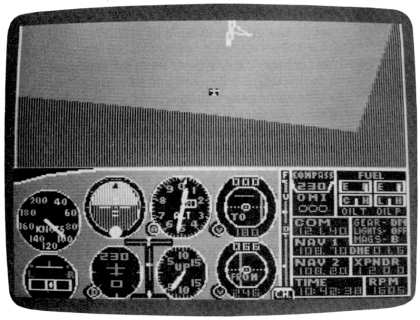40 More Great Flight Simulator Adventures
by Charles Gulick

Bull's-Eye
| North Position: 17560 | Ailerons: 32767 |
| East Position: 22134 | Flaps: 0 |
| Altitude: 4500 | Elevators: 32767 (IBM) |
| Pitch: 0 | Elevators: 34815 (Apple) |
| Bank: 0 | Elevators: 36863 (64 and Atari) |
| Heading: 200 | Time: 10:20 |
| Airspeed: 122 (IBM only) | Season: 4-Fall |
| Airspeed: 126 (all except IBM | Cloud Layer 1: 3000, 400 |
| Throttle: 23551 | Shear Zone Altitude 1: 5000 |
| Rudder: 32767 | Wind: 3 Kts, 230 |
 |
The weather being what it is,
your decision is to get on the ground as soon as possible. |
 |
You contact the Martha's
Vineyard tower on 121.4. The ceiling they quote you is pretty unbelievable-worse than the weather report. But, fortunately, the Martha's Vineyard ILS is in operation, so that's obviously the way to go. The tower gave you the ILS frequency, 108.7, so you crank it into NAV 1 and then tune NAV 2 to the Martha's Vineyard VOR, 108.2. You find you're well to the left of the 240-degree radial, and you want to get on it as soon as possible since you're only 15 or so miles out and you'll be landing on runway 24. You set the OBI on NAV 2 to 240, and turn right to a heading of 330. That's like putting yourself on base for runway 24. Sure enough, the needle on your number-two OBI comes into action in just a few minutes, followed shortly by the ILS centerline needle. When that's centered, you turn to track it and get down to the business of your approach. |
 |
You want to get into slow flight
and set up a descent rate of about 500
feet per minute, these being the ideals for an ILS approach. So you use
a combination of power reduction and up elevator trim until you get the
desired readings. They aren't achieved all at once. As you reduce
power, you'll start descending. But to hold the rate of descent at 500
fpm, you'll find you need to keep trimming. At the same time, you want
to decrease your speed. So you keep trading off one against the other,
the objective being to get the aircraft in balance at a steady rate of
descent and the KIAS you've established for slow flight. |
 |
Then your job is to keep both
ILS needles crosshaired on the center of
the instrument. Adjust power as needed all the way down to stay on the
glide slope. At 3000 feet, you'll be in the overcast. Don't let the
centerline indicator get away. Make minor heading adjustments
immediately if you stray from it by even a degree. Your primary
instruments now are the OBI and the artificial horizon, and your
primary control is the throttle. If the OBI display looks right, your
wings are level (or in a gentle bank if you're trying to center the
needle), and your nose is just a bit below the horizon. You're right
on. Stay there. Try to anticipate the glide slope and centerline needles. The centerline in particular will get more critical as you get closer to the runway. Shortly after the marker tones wake you from your hypnosis, you'll break out of the overcast and see the bull's-eye you set up on your OBI come to life in three dimensions. Doesn't that green look awfully welcome? |
Table of Contents | Previous Section | Next Section
